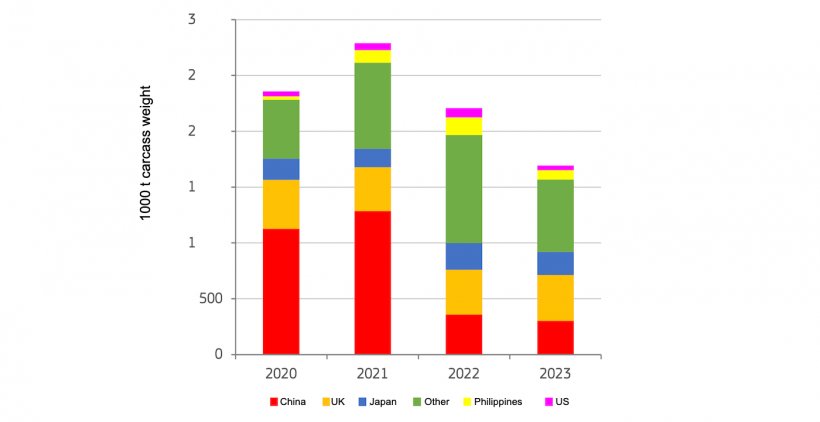In the first half of 2023, EU pigmeat production went down by -8.6%. The biggest reductions were recorded in DE (-210 000 t or -9.4%), DK (-180 000 t or -21.5%), and ES (-150 000 t or -5.8%). This low EU supply leads to record high domestic prices. However, since July, EU producer prices started to show signs of a decline. As feed prices are decreasing and margins remain positive, carcass weights are expected to increase in the second half of the year. Overall, a production decline of -6.6% is expected in 2023.
At the same time, EU demand stays firm but given reduced supply, a drop in EU per capita consumption is expected (-5%, to 30.4 kg). Besides reduced supply, the consumer considerations about price increases play an important role, which leads to a reduction of pigmeat consumption or a switch to other types of meat. In particular, pigmeat consumption is often reduced to the benefit of poultry meat. If supply rebounds slightly, and so this increased availability could relax even more producer prices, a small increase in per capita consumption might appear in 2024 as a reaction to this.


Less competitive EU pigmeat prices make exports to the global market a real challenge. In the first half of 2023, EU exports recorded a decline of -20%. Pigmeat production in China is recovering and so less imports are needed. At the same time, the EU loses market shares both in highvalue markets (US, Japan, Australia) and low-value ones (e.g. Philippines) due to stronger price competition. Only the UK market shows a slight positive development (+2.4% in JanJune). Overall, EU exports in 2023 could be down by -16%. If prices continue declining, some market shares might be regained, resulting in a 5% increase in 2024. EU pigmeat imports from the UK decreased by almost 19% in the first half of 2023, following an increase of almost 28% in 2022. The reason behind is the current decline in UK production. As the UK represents more than ¾ of EU imports and no replacement of other origins is expected in the short term, EU pigmeat imports may decrease by 20% in 2023.
October 9, 2023/ European Commission/ European Union.
https://agriculture.ec.europa.eu





